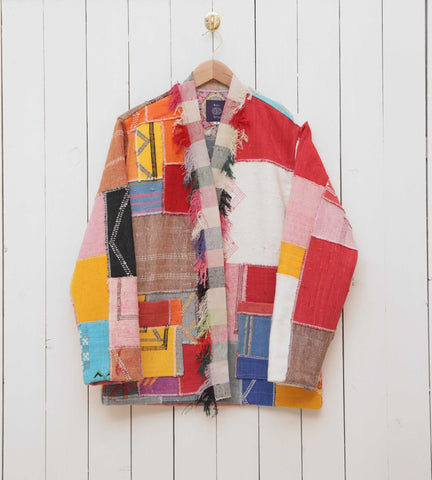Los Angeles, CA — Spring is just a couple weeks away. To stay fresh with the warming temperatures and extra daylight, in all cities except Aspen and Vail (we just got hit with 17" in 24 hours on Wednesday), our teams are rotating out their winter wardrobes from heavy coats into spring season's light-weight, layering pieces--workshirts, jackets & vests, sweatshirts, and kimonos.
Our identity, specifically--our style--tells a story to others about who we are and what we are really doing here. It's a feeling we put on each day when we decide to wear this instead of that. It's a daily, active choice each of us makes to show ourselves and others who we are today.
We choose to be aspirational, unconventional, and unique.
We are here to help you spark a bit of joy in your decision-making--with colors, textures, and patterns--all while maintaining a sense of sophistication through our classic cuts & silhouettes.
This brings us to our latest re-stock: our one-of-a-kind Handwoven Kimonos are designed by hand at our Marrakech atelier. Each kimono is made from up-cycling handwoven, colorful deadstock cotton fabrics -- otherwise known as Berber blankets -- hand-sourced in the Atlas region outside of Marrakech and in the old souks in the historic Medina in Marrakech.
Something that makes each of our collections more interesting is that they are connected with a story.
The Japanese Kimono
The Japanese created kimonos following the trade of Chinese silk robes during the 3rd century. They used inspiration from garments worn by the Chinese Wu dynasty. The Japanese evolved the style into a layered garment from the 8th to the 11th centuries.
First worn casually in the home, kimonos later evolved through the warrior classes and by the 12th century, they rose to an official uniform status. As time passed and merchant classes gained material wealth, they briefly enjoyed wearing the style until the ruling classes created laws prohibiting lower classes from wearing particular colors and patterns. These strict laws were in place in Japan until the late 1800's when the social class system was abolished.
In modern times, in both Japan and around the world, silk kimono tops are worn universally, and as a luxury style both inside and outside of the home.
Res Ipsa Kimonos
Our Handwoven Kimonos are a perfect example of making something unconventional and cool. We honor the Japanese-inspired kimono silhouette and make each kimono a modern, unique creation using global textiles.


Each kimono is imperfect. Each kimono is meant to be playful, colorful, and comfortable. Be it the particular way our tailors at our Marrakech atelier used hand-stitching to repair a minor tear in the fabric or just that one sleeve or pocket is patched with a completely different vibrant color or geometric pattern from the rest of the top, the blemishes and unique qualities make them feel all the more fun.
And while the handwoven fabric for each top provides plenty of warmth for this transitional winter-to-spring weather, we layer our kimonos--made using many different fabrics--year-round as they are light enough to layer in warmer seasons.
Shop all Kimonos:
Crochet Kimonos (sold out online - available in stores only)
Res Ipsa Handwoven Collection
Moroccan handwoven fabric is traditionally woven to be used as blankets and other home goods, including for towels, pillows, furniture and rugs.
Shop our handwoven collection, including:
---
#ResIpsa
#OurBrandisTravel














